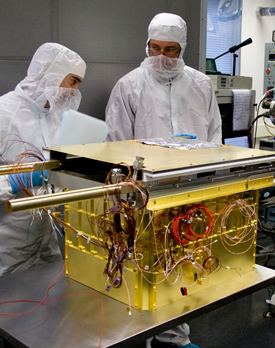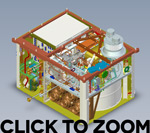SAM, I AM!
The Sample Analysis at Mars (SAM) investigation onboard the Mars Science Laboratory (MSL) Curiosity rover is designed to investigate the chemical and isotopic composition of the Martian atmosphere and volatiles extracted from powdered solid surface samples. It will conduct a sensitive search for organic compounds and measure the isotopic composition of carbonaceous material. SAM's investigations support the mission goal of quantitatively assessing the habitability of Mars, an essential step in the search for past or present life on Mars, with investigations in Gale Crater.

+ The SAM Instrument Suite [Click to Expand]
SAM is a suite of three instruments totaling 40 kg, located in the Curiosity rover's interior: a 6-column Gas Chromatograph (GC), a Quadrupole Mass Spectrometer (QMS), and a Tunable Laser Spectrometer (TLS). These instruments are coupled through solid and gas processing systems to provide complementary information on the same samples. Each sample may be analyzed by one, two, or all three of the SAM instruments.

The GC has six complementary chromatographic columns. The GC assembly sorts, measures, and identifies gases it separates from mixtures of gases by pushing the mixed gases through long, narrow tubes (wound into coils) with a stream of helium gas. It sorts the gas molecules by weight: they emerge from the tube in order from lightest (out first) to heaviest (out last). Once the gases are sorted, the GC can direct quantities of the separated gases into the QMS or TLS for further analysis.
The QMS identifies gases by the molecular weight and electrical charge of their ionized states. It fires high-speed electrons at the molecules, breaking them into fragments. It then sorts the fragments by weight with AC and DC electric fields. The spectra generated by the QMS detector uniquely identify the molecules in the gases.
The TLS uses absorption of light at specific wavelengths to measure concentrations and isotope ratios of specific chemicals important to life: methane, carbon dioxide, and water vapor.
Sieved powdered rock and regolith samples are delivered to small cups in SAM's Sample Manipulation System (SMS) by Curiosity's robotic arm through the solid sample inlet tubes. Atmospheric samples are collected through the atmospheric inlets.
The SMS has a wheel of 74 small cups where solid samples are accepted prepared for analysis in one of SAM's three instruments. 59 of the cups are quartz cups are small ovens that can be heated to very high temperatures to pull gases from the powdered samples. 9 sealed cups are filled with chemical solvents for lower- temperature wet chemistry experiments designed to search for certain polar organic compounds. The other 9 cups contain calibration materials.
The chemical separation and processing laboratory includes valves, pumps, carrier-gas reservoirs and regulators, pressure monitors, chemical scrubbers, and two ovens that can heat samples to about 1,000 degrees Celsius (1,800 degrees Fahrenheit). The wide range pump spins at 100,000 revolutions per minute to transfer gas out of the system between analyses of different samples.
+ The Search for Organic Molecules [Click to Expand]
The search for organic molecules is particularly important in the search for life on Mars because life as we know it cannot exist without them (though they can exist without life). SAM will be able to detect lower concentrations of a wider variety of organic molecules than any other instrument yet sent to Mars.
Both the presence and the absence of organic molecules would be important science results, as both would provide important information about the environmental conditions of the region. If SAM does find organic material, the next step would be to determine the origin and the nature of preservation of the molecules. If SAM does not find organic material, a better place to look might be below the surface.
+ SAM and Curiosity [Click to Expand]
Curiosity's primary science goals are to assess the biological potential of Gale Crater, characterize its geology and geochemistry, to investigate the role of water at the landing site, and to measure the spectrum of surface radiation. SAM will primarily support the first goal through highly detailed chemical analyses of a limited number of Martian surface and atmospheric samples.
In order to determine the best samples for SAM to analyze, the SAM team will rely on data collected by Curiosity's other instruments. The SAM team will work very closely with the other instrument teams in a synergistic mission approach to ensure the instruments obtain strategic, complementary datasets that will build a more complete picture of the landing site environment than any single instrument would be able to obtain in isolation, and also to make sure they use Curiosity's resources wisely.
For more information about SAM:
Abundance and Isotopic Composition of Gases in the Martian Atmosphere from the Curiosity Rover
- Paul R. Mahaffy, Christopher R. Webster, Sushil K. Atreya, Heather Franz, Michael Wong, Pamela G. Conrad, Dan Harpold, John J. Jones, Laurie A. Leshin, Heidi Manning, Tobias Owen, Robert O. Pepin, Steven Squyres, Melissa Trainer, and the MSL Science Team, Science Magazine, July 2013
A detailed scientific paper about SAM
- Paul Mahaffy and the SAM team, in Space Science Reviews, September 2012
Sample Analysis at Mars: Developing Analytical Tools to Search for a Habitable Environment on the Red Planet
- Paul Mahaffy, Geochemical Society publication, October 2009

